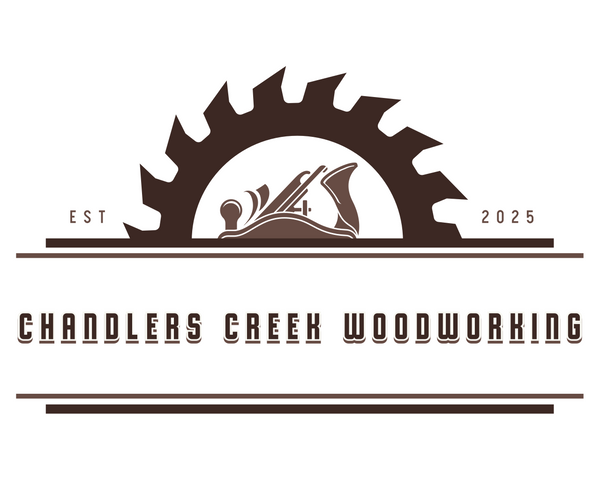Finding the Perfect Hardwood: How One Customer Chose the Right Wood for Their Custom Project
Introduction
At Chandlers Creek Woodworking, one of the most common questions we get from customers is: “Which hardwood should I choose?” It’s a great question — and an important one. The species of wood you pick doesn’t just affect how your piece looks; it also impacts durability, workability and how it will age over time.
Recently, one of our customers came to us with a vision: a custom-built sliding barn door that would serve as the focal point in their modern farmhouse living room. They knew the design they wanted — but were unsure which hardwood to choose.
We walked them through several beautiful options, explaining the pros and cons of each. Here’s what we shared — and how they ended up making the perfect choice.
1. White Oak: Strong, Subtle, and Timeless
Grain & Color:
White oak features a tight, straight grain with subtle ray flecks. It ranges from light tan to medium brown and accepts stain evenly.
Pros:
- Extremely durable and water-resistant
- Ideal for high-use areas like doors and countertops
- Elegant, timeless look
Cons:
- Heavier and slightly more expensive than red oak
Why Customers Love It:
A classic choice that balances strength and beauty, white oak fits almost any style — from rustic to refined.
2. Red Oak: Affordable, Familiar, and Versatile
Grain & Color:
Red oak has a more open grain pattern than white oak and displays warm reddish-brown tones.
Pros:
- Readily available and budget-friendly
- Takes stain well
- Strong and easy to work with
Cons:
- More porous than white oak (less moisture resistant)
- Grain is more pronounced and can look busy in some applications
Why Customers Love It:
Red oak is a go-to for traditional cabinetry, doors, and furniture — especially when cost is a factor.
3. Walnut: Dark, Rich, and Dramatic
Grain & Color:
Walnut boasts a swirling, luxurious grain in deep chocolate tones, with occasional lighter sapwood accents.
Pros:
- Naturally rich in color — rarely needs stain
- Beautiful figure and grain variation
- Finishes to a sleek, smooth surface
Cons:
- Higher cost
- Softer than oak or maple (more prone to dents)
Why Customers Love It:
Walnut makes a bold, sophisticated statement — perfect for heirloom furniture and upscale interior accents.
4. Cherry: Warm, Refined, and Ever-Changing
Grain & Color:
Cherry has a smooth, subtle grain and starts out light pinkish-red, darkening to a deep amber over time.
Pros:
- Ages beautifully and evenly
- Finishes to a silky, rich surface
- Easy to shape and sand
Cons:
- Sunlight accelerates darkening
- More susceptible to dents and scratches
Why Customers Love It:
Cherry is for customers who love the character of wood that deepens and evolves with age.
5. Maple: Bright, Clean, and Modern
Grain & Color:
Hard maple is pale and uniform in color with minimal grain movement. Subtle variations sometimes include birdseye or curly figuring.
Pros:
- Incredibly hard and durable
- Excellent for modern, clean aesthetics
- Great for light finishes or painted surfaces
Cons:
- Can be tricky to stain (blotching possible without conditioner)
- Less grain interest compared to woods like walnut or hickory
Why Customers Love It:
Maple is a top choice for bright, contemporary designs or durable work surfaces. Maple is best suited for painted finishes.
6. Hickory: Rustic, Bold, and Full of Contrast
Grain & Color:
Hickory is known for striking contrast between cream-colored sapwood and darker heartwood, with a bold, varied grain.
Pros:
- Exceptionally strong and impact-resistant
- Distinctive look adds character
- Ideal for rustic or farmhouse designs
Cons:
- Dense and harder to work with
- Grain variation can be overwhelming in large panels
Why Customers Love It:
For rustic charm and visual drama, hickory delivers every time.
7. Mahogany: Elegant, Stable, and Timeless
Grain & Color:
Mahogany offers a straight, ribbon-like grain with rich reddish-brown tones and a deep natural luster.
Pros:
- Excellent dimensional stability (resists warping)
- Takes finish beautifully
- Elegant, classic appearance
Cons:
- Imported hardwood — generally more expensive
- Slightly softer than domestic hardwoods like oak
Why Customers Love It:
Mahogany adds a refined, traditional elegance to doors, desks, and fine furniture.
8. Sapele: Exotic, Durable, and Eye-Catching
Grain & Color:
Sapele is similar to mahogany but with more pronounced interlocking grain and shimmer (chatoyance). Its color ranges from golden to reddish brown.
Pros:
- Durable and strong
- Stunning ribbon grain patterns
- Excellent alternative to traditional mahogany
Cons:
- Interlocking grain can make planing tricky
- Slightly darker and heavier than genuine mahogany
Why Customers Love It:
For customers who want exotic beauty with lasting durability, sapele delivers striking visual appeal with a luxurious finish.
How Our Customer Chose Their Wood
After comparing samples and hearing about each option, our customer ultimately chose White Oak. They loved its balanced appearance — clean and modern, yet warm and rustic. The subtle grain and neutral tone worked beautifully with their space, and its durability gave them peace of mind for everyday use.
Final Thoughts
Every hardwood has its own personality — from the deep richness of walnut to the rustic contrast of hickory, the elegant simplicity of maple, and the exotic shimmer of sapele. Whether you want a bold statement or a subtle, timeless backdrop, the right wood species sets the tone for your entire project.
At Chandlers Creek Woodworking, we offer expert guidance and hands-on support to help you choose the perfect wood for your home. Let’s work together to build something beautiful — one board at a time.
Have a Project in Mind?
Contact us today to request samples, ask questions, or start designing your custom piece. You can also explore our full selection of hardwood options in person or online.
